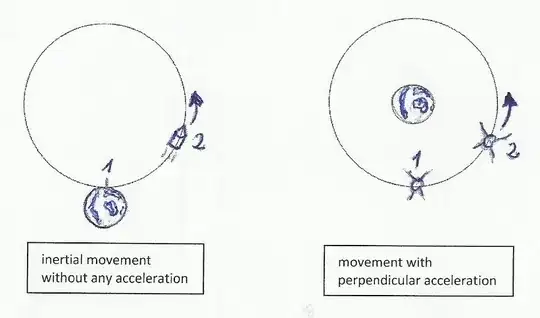First, let's imagine the ''standard'' twin paradox--you have one observer coinciding with the $y$-axis. The second observer travels out with an angle greater than $45$ degrees, and then has to have a turnaround time, after which they rejoin the $y$ axis and compare ages. The second observer ages less because they travel a path between the two ``meeting'' events that takes less proper time. The non-equivalence of the two paths is forced by the kink. In particular, if you draw equal-interval light rays leaving the non-accelerating observer, you will see how the moving observer suddenly sees them age as they accelerate.
Now, let's imagine the situation you describe--to do this, imagine a paper strip that is infinite int he $y$-direction, and has the topology of the ``asteroids'' game in the $x$-direction. This describes a geometrically flat ring evolving in time (adding more dimensions doesn't change the physical picture for this problem much, but makes the whole thing a lot harder to picture mentally). Our two observers travel out at equal speeds in opposite directions from a common point. They go to the edge of the strip and come out the other end, and meet up in the middle. Who thinks that they're older? No one! The paths obviously have equal proper lengths. How does this match up with their perception of each other? Well, just draw the light rays leaving the two observers on your paper--when they come out the other end, they suddenly see aging in the other observer--the act of going ''around the world'' makes it seem like the apparent age of the other observer is suddenly increasing just enough so that when they sync back up, their ages are equal.
Also, note that you don't really need general relativity here--a cylinder is intrinsically flat (or at least, it can be), and so there is no matter here, and local frames of a size less than the diameter of the universe will be able to map themselves, undistorted, onto ordinary Minkowski space. This is all topology.
EDIT:
In the end, all of this can be worked out, just as I said, by drawing lines on paper, identifying sides with each other, and using the rule $\tau^{2} = t^{2} - x^{2}$, where $x$ is the horizontal 'space' distance traveled, $t$ is the time elapsed in the global frame of the torus (or the preferred frame, if you will), and $\tau$ is the amount of aging of the relevant observer in their frame. All it takes is paper and rulers.
And once you talk about preferred frames, you do violate the spirit of Einstein's postulates. This doesn't mean that you can't talk about things consistently. Special relativity on a torus is still perfectly consistent, it's just not a theory in which all frames are equivalent. Also note that the speed of light limit will still be valid--the underlying local geometry will still be identical to SRT. You just will have differences when observers go 'around the world'. This is the difference between geometry and topology.
EDIT II, electric boogaloo:
The asymmetry comes from the fact that the universe itself has a reference frame, and its size will lorentz contract. This is measurable by the people themselves--all that needs to happen is to send out a light ray and wait for the light ray to go around the world. The 'diameter of the universe' will be (light orbit time)/c. This time will be observed to be smaller the faster the observer is travelling. So all observers will agree that there is a global, absolute notion of motion, and this will pick out who ages when.
If you're worried about the translational invariance, note that you're gluing $x=0$ to $x=L$, but a Lorentz transformation is going to mix space and time coordinates, so to a moving observer, this will be gluing $\frac{x-vt}{\sqrt{1-\frac{v^2}{c^2}}} = 0$ to the same expression equal to $L$, and will involve a mixing of space and time coordinates--the boundaries will appear to move.
